The generic term ‘Mozambiques’ was used in the late 18th and during the 19th centuries to refer to captives deported to the Mascarene islands from east Africa. Apparently, the African captives appropriated the term when defining themselves and Froberville constantly questioned them with the aim of determining their “true nations”.
Between 1845 and 1847, Froberville questioned over 350 East Africans, mainly men, on Bourbon and Mauritius islands. Most of them had been deported and shipped to these sugar plantation islands between 1810 and 1830, in the context of the illegal slave trade. From these former captives, Froberville gathered a wealth of information (linguistic, geographical and ethnological) concerning their countries of origin, which we can situate as currently being Mozambique, Malawi and Tanzania.
The notes, drawings and correspondence of the French ethnographer were for a long time conserved in the Huet de Froberville private archives, which I was lucky enough to be able to consult at the end of 2018. An analysis of the notebooks and other manuscript notes made by Eugène de Froberville has made it possible to reconstruct the ethnological study he carried out on the Mascarene islands, identifying 140 former African captives among the 350 questioned by Froberville on Bourbon and Mauritius, as well as tracing their origins and life stories. While on the British colony of Mauritius, the ‘Mozambiques’ questioned by Froberville in 1846 had been emancipated for about 10 years, on Bourbon island, they were still enslaved.
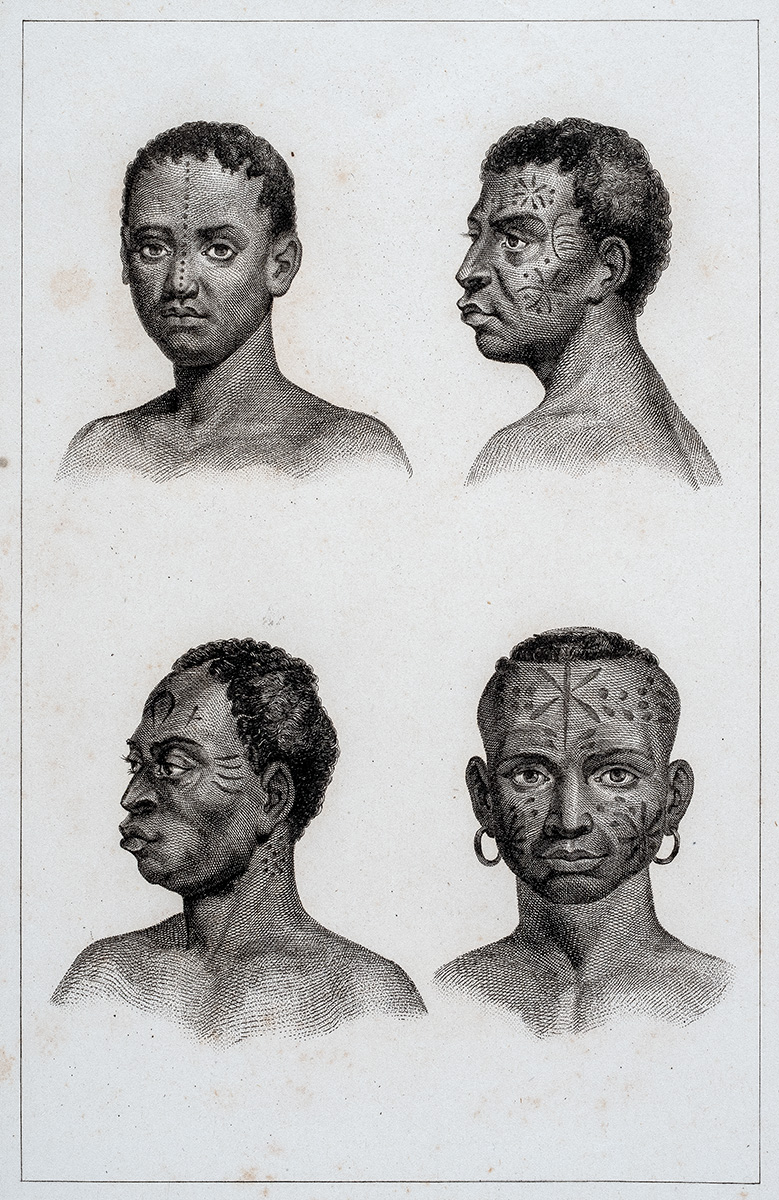
In this paper, I will focus on the enslaved East Africans interviewed by Froberville during his stay on Bourbon island in November 1845. During his short two-week stay, the ethnographer claimed to have studied some 200 ‘Mozambiques. Most of them had the task of tending to the crops on the estates or were exploited as craftworkers in one of the towns. Others were enslaved domestic servants. Certain of the ‘Mozambiques’ interviewed by Froberville gave an oral account (in Creole) of their life story, bearing witness to the violence of slavery on Bourbon, just a few years before abolition: “I spent my days questioning these poor slaves, hearing their dreadful life-story,” wrote Eugène de Froberville in 1846. The ethnographer did not record in his notebooks the content of these accounts of slavery on Bourbon, which would have been extremely precious, since accounts of the lives of the enslaved in the French colonies are extremely rare, even non-existent. He was more interested in the countries of origin of these former captives born in East Africa. What we can therefore read in his notebooks are scraps of oral accounts and information (notably of a linguistic character) that the ‘Mozambiques’ communicated about their East African countries of origin. From these notes, among those he interviewed it has been possible to identify four men and one woman, with their names, origins, languages, cultural practices, and part of their itinerary from Mozambique to Bourbon. Cross-referencing Froberville’s private archives with elements from the Departmental Archives of Reunion has made it possible to confirm the identity of two of these enslaved persons, and to complete the gaps in their itineraries, as well as their possible lineage.
After 79 days at sea sailing from France, Eugène de Froberville and his wife Caroline landed on Bourbon on 12th November 1845, where they then spent between 17 and 20 days, before leaving for Mauritius. Their correspondence during this stay on Bourbon has enabled us to reconstruct the context of the ethnological and linguistic study carried out by Eugène de Froberville among the enslaved workers originating in Africa. In a letter sent to his cousin Amélie de Froberville, Eugène declares that during his stay on Bourbon, he carried out “a study of the Africans working on the estates”. Hubert Gerbeau demonstrated that the illegal trade on Bourbon had directly supported the sugar economy on the estates. Other members of the group of ‘Mozambiques’ referred to by Froberville were craftsmen employed in workshops or as domestic workers in Saint-Denis. Eugène de Froberville gained access to these slaves through the slave owners themselves, with whom Froberville and his wife were staying. In Saint-Denis, they stayed with Adolphe Lory, in Sainte-Marie with the widow of Gustave de Tourris and in Sainte-Suzanne with Louis de Tourris (Gustave’s son) who owned an estate there. The Reunion Departmental Archives of have provided us with precious information concerning the Lory and the de Tourris families, who were settlers coming from Mauritius to Reunion, respectively in 1826 and 1827. During the same period, in 1827, Prosper Huet de Froberville (1791-1839), Eugène’s father, left Mauritius with his family to settle in France. At the head of several commercial companies (registered in Mauritius, and in France), Prosper had set up economic relations in Bordeaux and Liverpool, apparently taking advantage of the more favourable conditions offered by the British regarding the price for sugar brought in from the colony of Mauritius as from 1825. We can easily conclude that Adolphe Lory (an industrialist and trader), Gustave de Tourris (an industrialist settled on the island) and Prosper Huet de Froberville (a trader), all three of the same generation and born in Mauritius, maintained social and/or economic relations. The fact that Eugène de Froberville provided Lory the elder with information concerning the sugar industry on Mauritius supports this hypothesis. It is also likely that Froberville and his spouse had family links with certain important land-owning families on Reunion. Eugénie Huet de Froberville (maiden name Bon), was a distant relative of Mme Desbassayns. The latter had invited the young Froberville couple to stay on her estate in November 1845, but Mme de Villèle’s daughter having fallen sick, the invitation was not taken up.
Eugène de Froberville devoted his stay on Bourbon island to the study of East African languages. His notebooks contain a large amount of vocabulary obtained from the ‘Mozambiques’ in Saint-Denis, Sainte-Marie and Sainte-Suzanne. Froberville thanked the estate owners Adolphe Lory and Louis de Tourris for granting him access to “the East African slaves in their possession, the former in his workshops in St Denis and the latter on his estate in Sainte-Suzanne”. ‘Makua’ and ‘Niambane’ vocabulary was also collected in Sainte-Marie on the estate of the widow de Tourris, Louis Nas de Tourris’s mother, who had invited the Froberville couple to spend a few days on her estate.
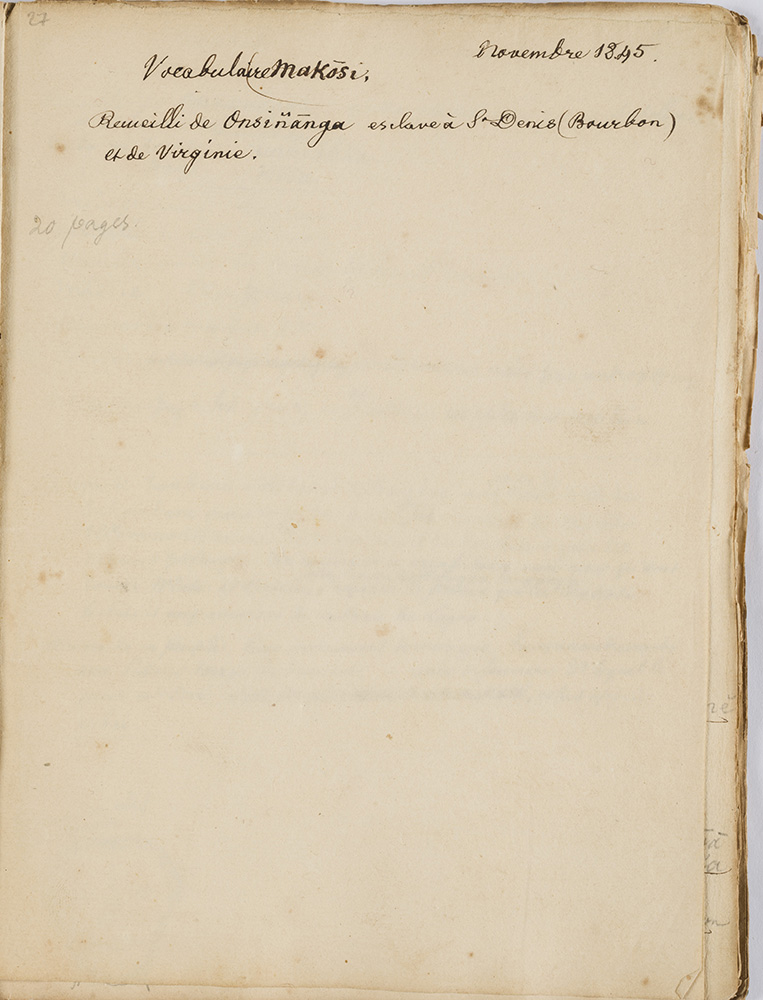
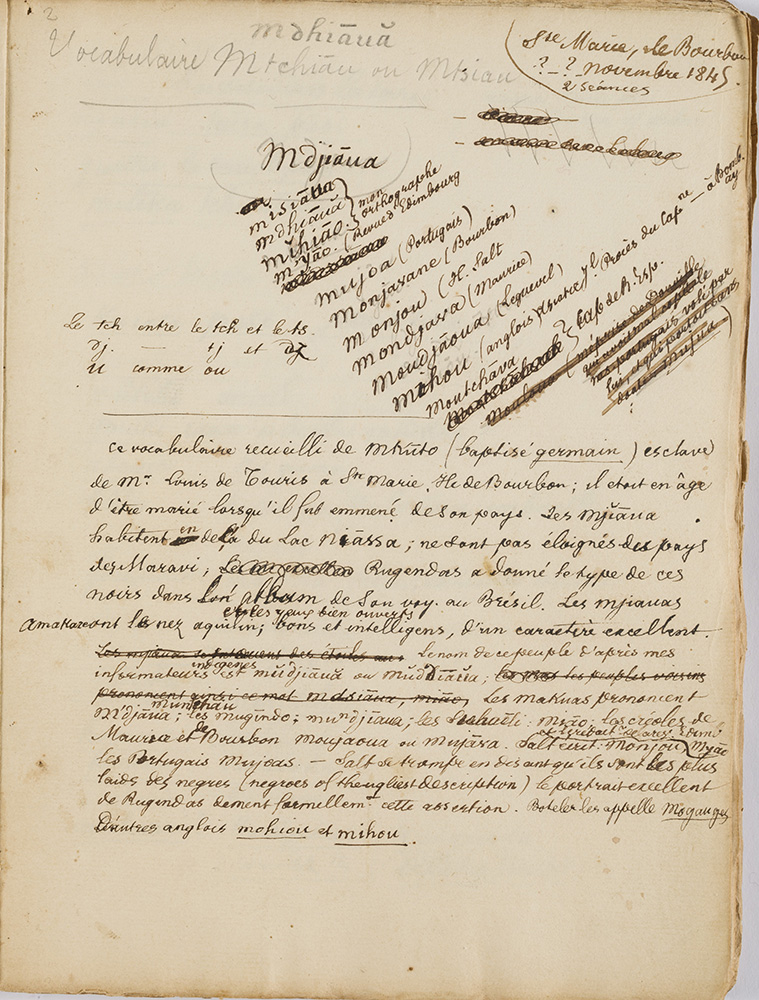
In Saint-Denis, Froberville spent his time collecting “vocabulary from all the Makua Blacks he met”, his wife Caroline declared. Apparently, Froberville interviewed mainly men, who worked in large numbers on the estates. The men slaves referred to as ‘Cafres’ working on the de Tourris estate in Sainte-Suzanne were nearly all assigned to working in the fields. In Sainte-Marie, on the de Tourris estate, “Eugène continued to work on Makua and Niambane”. All in all, on Bourbon island Froberville drew up four lists of vocabulary in the languages of the ‘Moadjaoua’ [Yao], ‘Maravi’, ‘Makoua’ [Makua], and ‘Makōssi’ [or ‘Cafre’, also confused with the category referred to as ‘Niambane’]”.
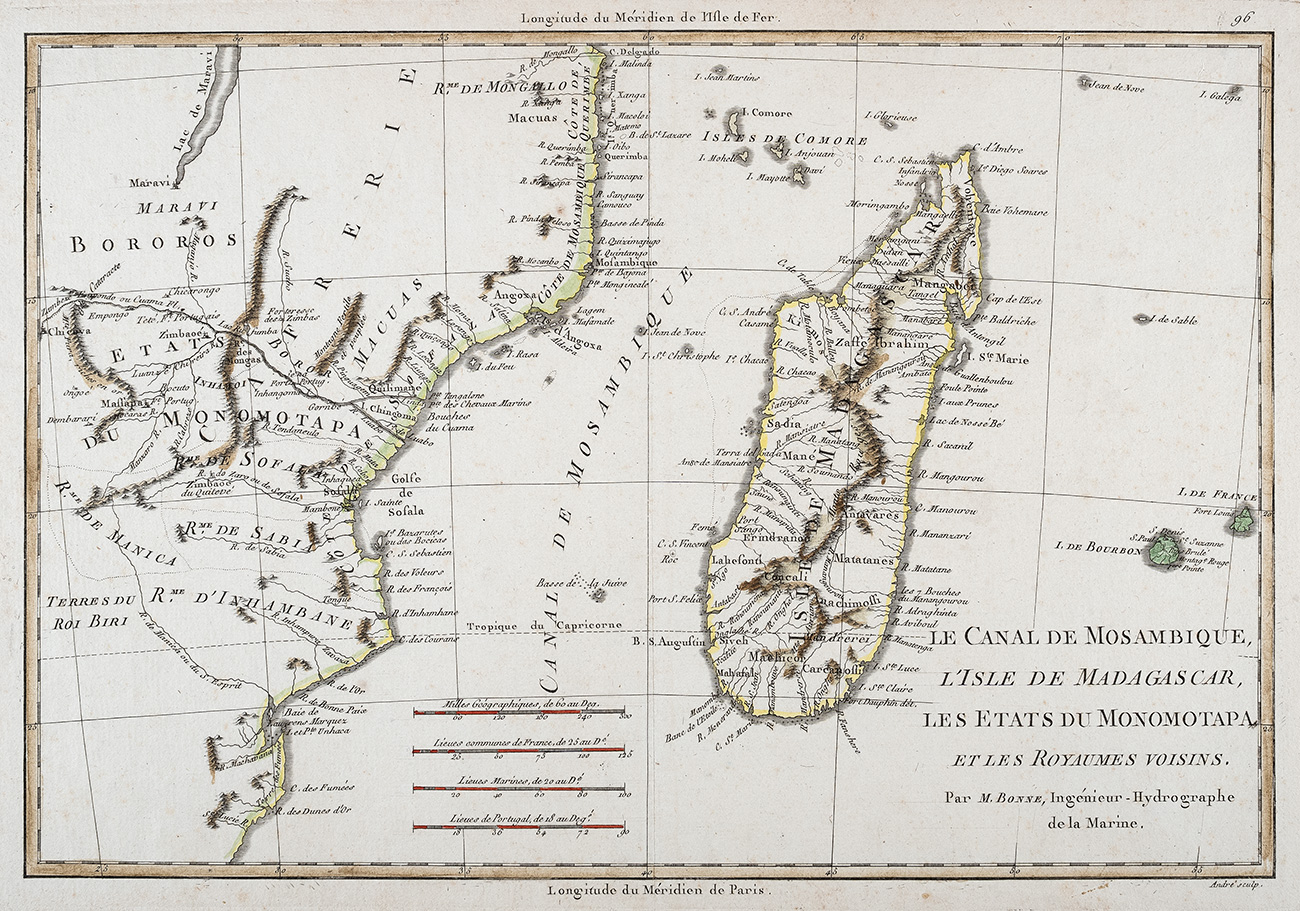
The Yao and Makua languages, as well as those of the Maravi (Chewa and Manganja) are still spoken today in Mozambique. The term ‘Niambane’ or ‘Yambane’ was a general term used on Bourbon island, when referring to all the captives deported through the port of Inhambane, located in the south of Mozambique, and was not based on any socio-linguistic reality. The vocabulary collected from those referred to as ‘Niambane’ probably originated in the languages commonly used in the region around Inhambane.
The fact that in 1845, former captives of the illegal slave trade, brought onto Bourbon island sometimes several decades previously, remembered, and perhaps practised African languages appears as a form of cultural resistance against the dehumanising effect of slavery.
The enslaved Africans interviewed by Froberville provided oral accounts of their lives using the Creole language that Froberville, who was born on Mauritius island, had not difficulty understanding. For the society of estate owners on Bourbon, this aristocrat arriving from Paris was seen as a curiosity, an eccentric spending his days questioning slaves.
“The settlers could not understand my interest in this task and several reacted with derogatory smiles. The idea of chatting with a Black, seeking out feelings and ideas from under that ugly envelope! I certainly had nothing better to do! they would say,” wrote Eugène de Froberville.
Discussions with the masters and the accounts given by the enslaved apparently convinced Eugène de Froberville that the violence of the system on Bourbon island was so appalling that slavery in the French colonies would have to be abolished. The women estate owners were particularly brutal with their slaves.
“My conversations with the inhabitants of Bourbon island have turned me into a philanthropist: I do not believe that slavery is beneficial for the Blacks. These people, considered so coarse, experience misery, something I could feel when I saw their tears brought on by the the brutality of their treatment by the ladies and young girls. Mme Trollope has perfectly expressed the way in which the island’s mistresses speak to and make use of their slaves. There is nothing more revolting,” Eugène de Froberville wrote in a letter to his mother.
During a trip to Salazie, his wife Caroline was seated in a sedan placed on poles carried by slaves, each in turn. These slaves, who had apparently previously transported “all the women on Bourbon”, belonged to Mme Lory, the owner of an estate close to the mountains of Salazie.
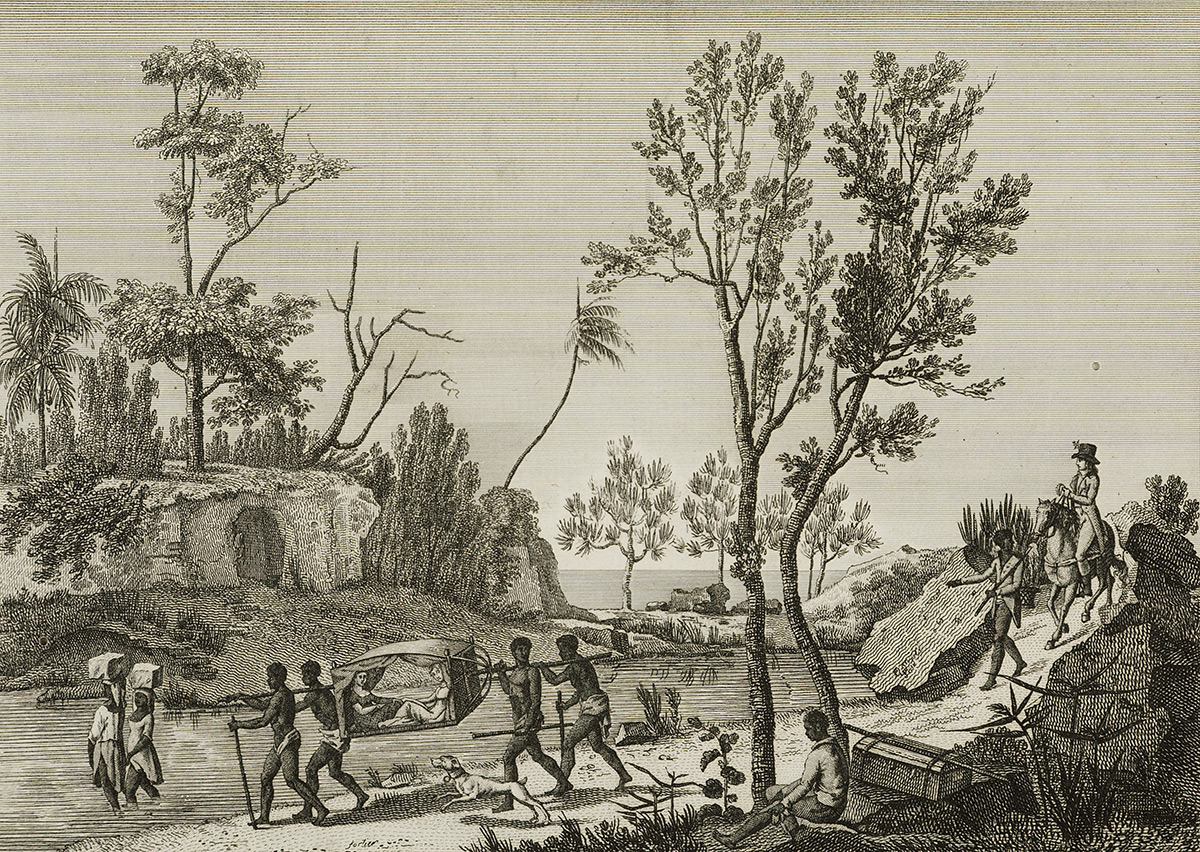
Born in Mauritius in 1815, in a colonial slave-owning society, Eugène de Froberville had left his native island to settle in France at an early age (the age of 12). It was during his stay on Bourbon in 1845 that he realised that slavery was “something dreadful”. This rejection of the violence of slavery by a member of the colonial elite of the Mascarene islands went against the aristocratic memory, which for a long time attempted to communicate the image of a form of slavery on Bourbon as more ‘human’ than elsewhere.
“The settlers on Bourbon, who issue declarations in which they officially claim that the slave is morally and physically the happiest in the world, know that they are officially lying. This political-social bad faith does not prevent the inhabitants of Bourbon from being friendly and hospitable. They show great goodwill to anyone with a white skin,” wrote Froberville.
Actually, Eugène de Froberville’s discourse was very ambiguous, since he adapted it greatly, depending on who he was addressing. With his hosts, there is no doubt that he did not share his abolitionist ideas. Froberville was fully a member of the society of masters and even the colonial elite of the Mascarene islands. It was his high rank that actually enabled him to partly transgress the customs of the period, creating a different relationship between a member of the society of white masters and African slaves: a relationship based on domination, steeped in prejudices, at the same time recognising the enslaved as having knowledge and being cultural actors.
Among the native Africans interviewed by Froberville on Bourbon in 1845, are those named Virginie, Onsinānga, Malāssi and Mtchirima Thomas, who were legally slaves belonging to Adolphe Lory in Saint-Denis, as well as Mkūto Germain, a slave belonging to Louis de Tourris on his estate in Sainte-Suzanne.
The account given by Virginie is all the more exceptional as she was the only woman interviewed by Froberville on Bourbon island whose name has been recorded. Froberville does not record her original name, only the one she was given on arriving on Bourbon island, to where she was deported before being enslaved.
Virginie was apparently born around 1809 in the south of what is currently Mozambique. Froberville presents her as a ‘Makossi-Niambane’, which indicates that she came from this region in the south. She provided the ‘Makossi’ vocabulary, recorded by Froberville in his notebooks in the form of a French-Makossi lexicography of 20 or so pages. Apart from the memories of her language, Virginie had the cultural markings of her country of origin. Froberville mentions the “tattoo in relief” present on Virginie’s forehead, representing a line of ‘dots’ going from the top of her forehead down to the tip of her nose, characteristic of the ‘Niambane’. Such tattoos were created using a small hook and a knife: “The skin is lifted using the hook, then a cut is made”. This was, in fact, a form of scarification commonly applied among various groups in the south of Mozambique.
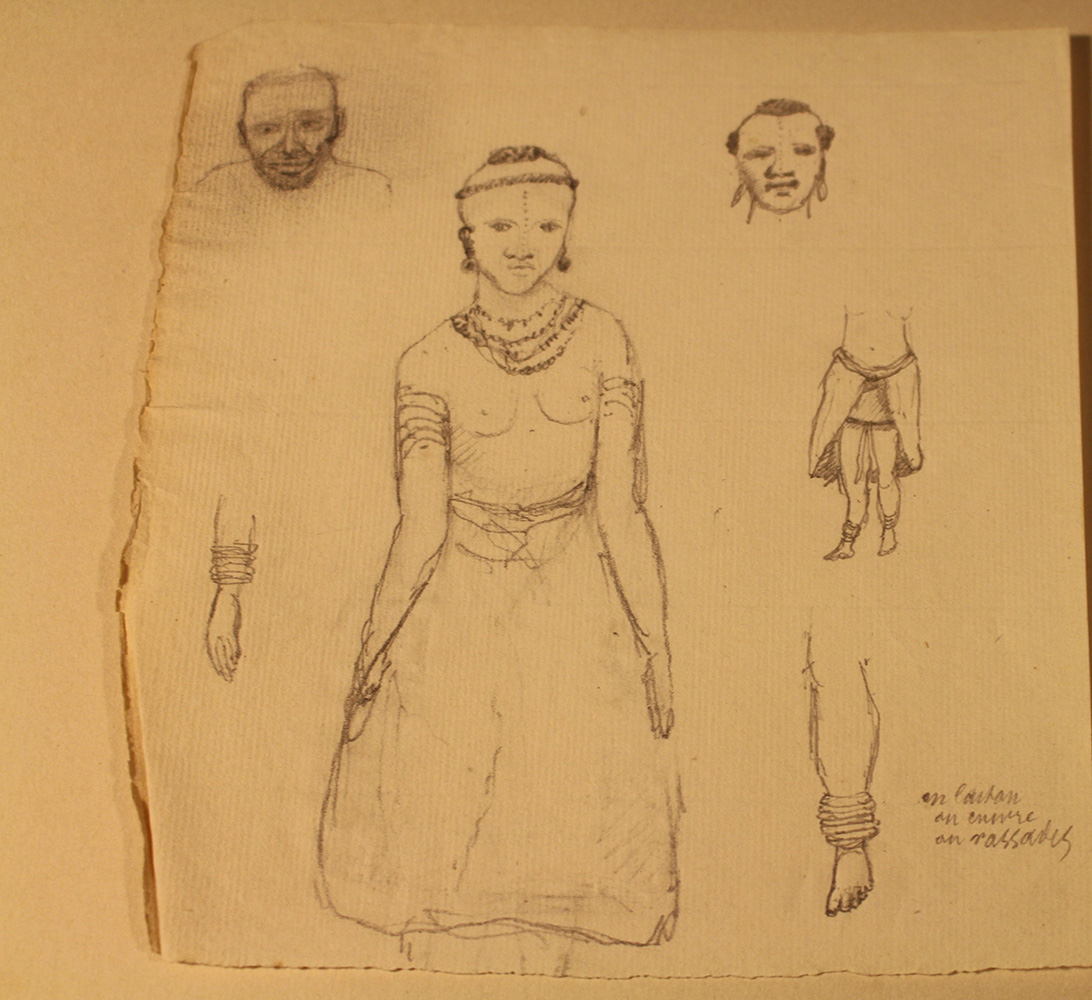
The above drawing was probably one made by Forberville during his stay on Bourbon Island in November 1845. It is the only portrait of a ‘Niambane’ woman drawn by Froberville, and could well represent Virginie.
The fact of bearing a tattoo may indicate that the person had already been initiated into the knowledge of his or her original social group before being brutally removed from it. For boys, this involved undergoing the rites of circumcision, and for girls having their first period. We can conclude that Virginie was at least 10 years old when she was deported, during the 1820s or the early 1830s, taken from the coast in the south of Mozambique, probably the coastal zone around Inhambane, before being shipped to Bourbon. Several illegal slave-trade expeditions transporting captives referred to as ‘Yambane’ were recorded on Bourbon during this period, notably those involving the vessel Deux-Frères in 1826 and that of Marie in 1827. Virginie is recorded in the 1840s censuses as one of the slaves belonging to Lory senior in Saint Denis. The conversations between Froberville and Virginie in 1845 may have taken place in the mansion belonging to Adolphe Lory in Saint-Denis. In 1848, Virginie was listed as a domestic worker, aged 39, of the ‘Mozambique’ caste, measuring 1m60 and bearing “specific signs or marks of her country of origin”: the facial tattoos described by Froberville.
Other slaves belonging to Lory interviewed by Eugène de Froberville in Saint-Denis in 1845 were described as being ‘Makossi-Niambane’. Among these, Malāssi and Onsinānga [Onsignānga] respectfully provided ‘Niambane’ and ‘Makossi’ vocabularies.
Onsinānga recounted that he had left his country at a young age. From the toponyms and ethnonyms given, we can conclude that he was originally from the south of what is now Mozambique. Onsinānga provided Froberville with ‘Makossi’ vocabulary and may have discussed grammar and phonetics with him. Concerning this African slave, Froberville noted “the man is highly intelligent.”
Of the various ‘Niambane’ cultural traditions (tattoos and decorative practices ), Froberville mentions their music and dancing. He mentions their “hideous accoutrements when dancing”. The remark, steeped in prejudice, is interesting in that it suggests that Froberville was actually able to observe scenes of ‘Niambane’ dances on Bourbon in 1845. We have beautiful drawings and sketches made by Froberville representing these ‘Niambane’ dances, showing their movements dancing in the round or lines of men and women sharing cultures.
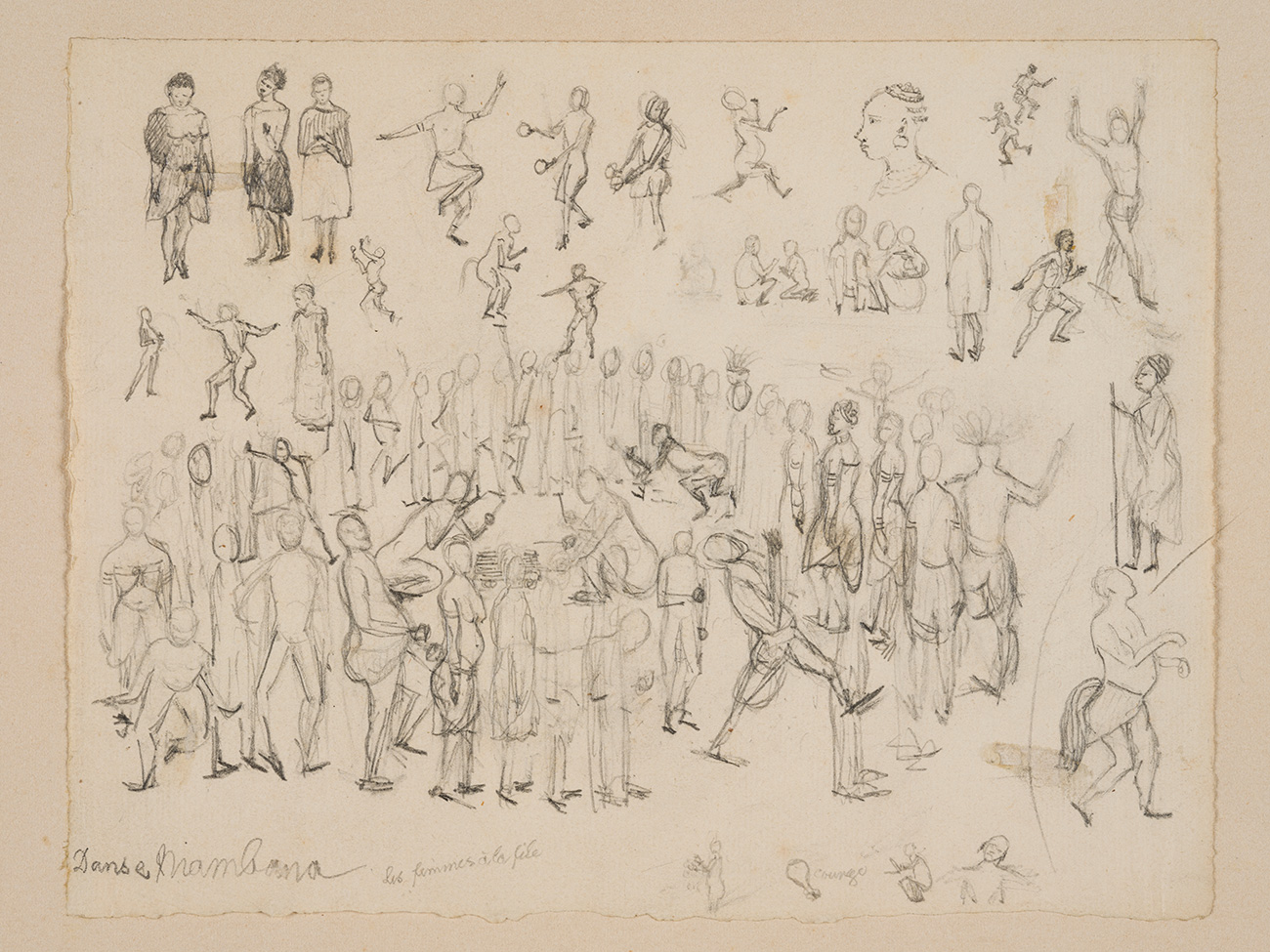
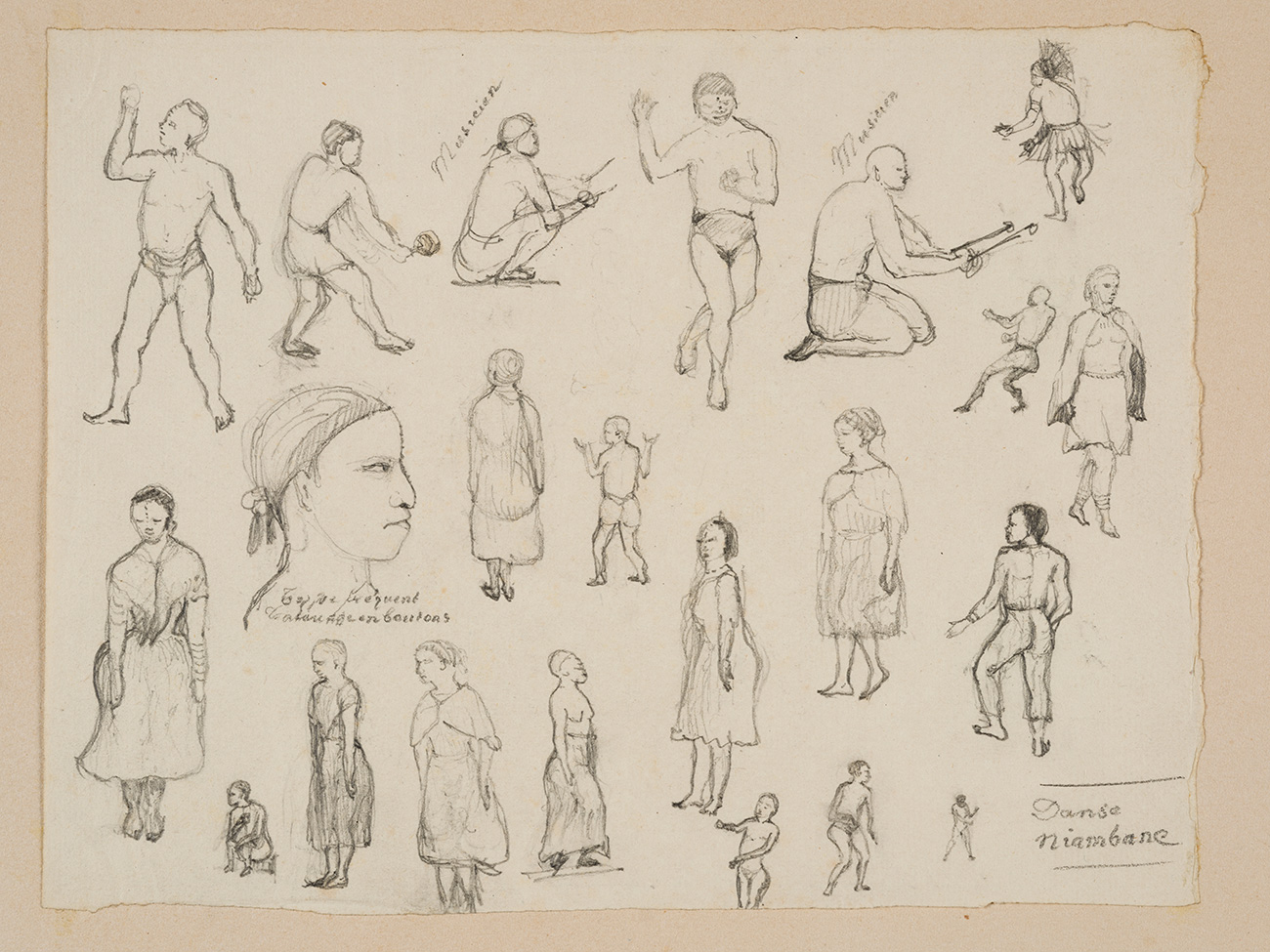
Between 20th and 25th November 1845, Froberville interviewed another one of Adolphe Lory’s slaves in his workshops in Saint-Denis. Born around 1806-1810 in what is currently Mozambique, “Mtchirima Thomas” belonged to the group of Maravi origin, which occupied a vast territory in the centre-west of Mozambique, in a region sharing a border with Malawi. The toponyms and ethnonyms he mentions have made it possible to locate the region he came from fairly precisely: two weeks south of Lake Niassa and a day’s walk from Senna, a Portuguese garrison along the Zambesi river, that the Maravi called ‘Lombādzi’. From the interior of the Zambezi valley, he was taken by force, probably to the port of Quelimane. His name ‘Mtchirima’ is undoubtedly a term derived from ‘Tsirimane’, used locally to refer to Quelimane. Around 1825, when he was 15 or 16 years old, he was deported to Bourbon, in the context of the illegal slave trade. Several clandestine expeditions recorded by the Portuguese in Quelimane in 1827 and 1828 can be linked to ships involved in the trade supplying slaves for Bourbon. Once on the island, Mtchirima was given the name of Thomas. In the workshops in Saint-Denis, where the slaves belonging to Lory were forced to work as labourers, smiths, boilermen or foundry workers, Mtchirima Thomas provided Froberville with a large quantity of ‘Maravi’ vocabulary (some 80 pages). Among the slaves listed as belonging to the Lory and Pitel company in Saint Denis in 1841, there is a certain Thomas, aged 35, labourer, bearing the “marks of his country”. All these elements correspond to the data Froberville collected from Mtchirima Thomas, who had the tattoo of the Maravi. This consisted in a sort of star carved out on the forehead, the temples and the chest. The Maravi would also file their incisors down to a point.
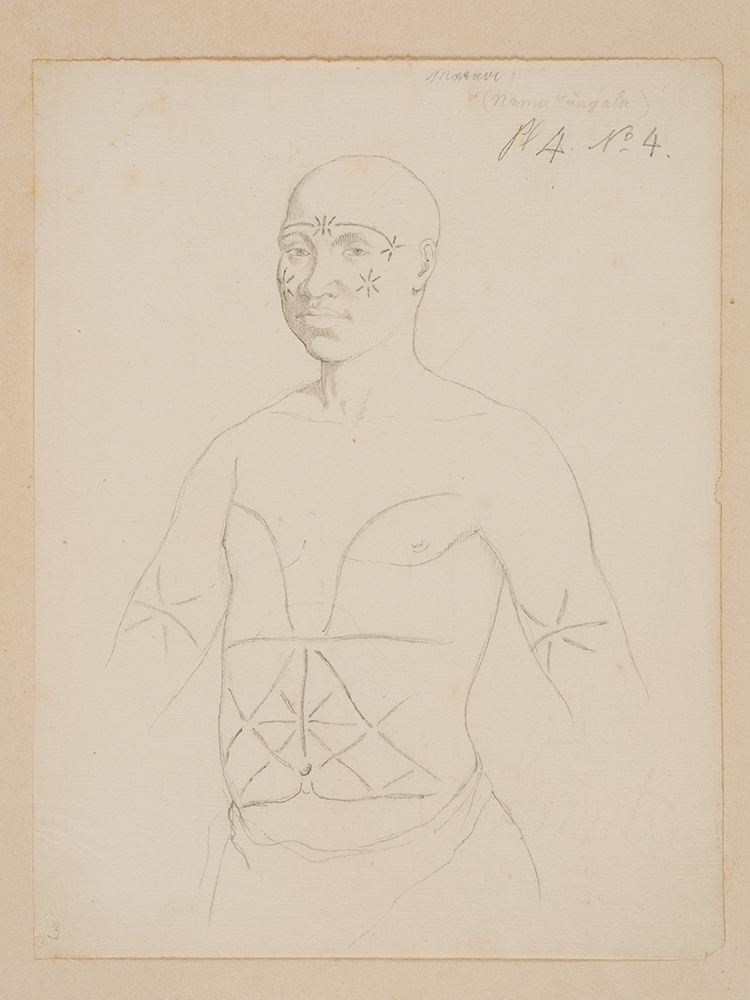
In Sainte-Marie, Froberville interviewed Mkūto, who had been christened and given the name of Germain and who belonged to Louis de Tourris. Mkūto was old enough to be married when he was taken out of his native country.
Referred to on Mauritius and Bourbon islands as the ‘Moujaoua’, ‘Mujāva’ or ‘Monjavane’, the Yao occupied a territory in the north-west region of what is now Mozambique. Yao captives were forced to walk sometimes several months before reaching the coast at Kilwa or Moçambique. A slave trader working in the Mascarene island in the early 19th century noticed that in the latter slave-trading port, the Yao represented the majority of the captives. Chained up and herded together in the ships, those who survived the sea crossing became slaves on the plantations on these islands. Mkūto, who was one of these, had retained a memory of his country and the use of his language of origin. Froberville’s notebooks contain some 30 pages of vocabulary, words translated from French by Mkūto.
On Bourbon island, Yao may have been the language used by fugitive slaves to communicate among themselves. Published in a recent work by the historian Jérémy Boutier, a text by Auguste Logeais contemporary to the 1840s refers to dialogues between “maroon” (fugitive) slaves using a hitherto unidentified African language. On the basis of Froberville’s notebooks, it has been possible to determine this language as being Yao.
In the context of slavery, retaining memories of their East African country of origin, original names (individual and collective), languages or music and dances, can be seen as forms of cultural and identity resistance by the ‘Mozambiques’, who were among the last to be enslaved through the illegal trade to Bourbon island.
Allen, R. B., 2001, ‘Licentious and Unbridled Proceedings: The Illegal Slave Trade to Mauritius and the Seychelles during the Early Nineteenth Century’, The Journal of African History 42, no. 1, p. 91-116.
Alpers E. A., 2005, ‘Mozambique and ‘Mozambiques’: Slave Trade and Diaspora on a Global Scale’, in B. Zimba, E.A Alpers et A.A. Isaacman (eds.), Slave Routes and Oral Tradition in Southeastern Africa, Maputo, Filsom, p. 39-61.
Alpers E. A., 2001, ‘Becoming ‘Mozambique’: Diaspora and Identity in Mauritius’, in V. Teelock & E. A. Alpers, History, Memory and Identity, Nelson Mandela Centre for African Culture, Mauritius, p. 117- 155.
Boyer-Rossol K., 2024, ‘Les carnets de l’ethnographe Eugène de Froberville (1845-1847): des noms et des voix de captifs déportés de l’Afrique orientale aux îles Mascareignes’ (The notebooks of the ethnographer Eugène de Froberville (184-1847): names and voices of captives deported to the Mascarene islands from East Africa), in S. Zimmerman et N. Marvin (co-dir): ‘Gender and Slavery: Re-centering the Archives’ Esclavages & Post-Esclavages, n°9.
Boyer-Rossol K., 2015, ‘Entre les deux rives du canal du Mozambique: Histoire et Mémoires des Makoa de l’Ouest de Madagascar. XIXe-XXe siècles’ (Between the two banks of the Mozambique channel: history and memory of the Makoa from the west of Madagascar. 19th-20th centuries). Doctoral thesis on African history directed by Faranirina Rajaonah (Université Paris 7 Diderot) and co-directed by Gabriel Rantoandro (University of Tananarive), University of Paris.
Colin E., 1809, ‘Notice sur le Mozambique’ (Notes on Mozambique): Annales des Voyages, de la Géographie et de l’Histoire, 9, p. 304-238.
Eyriès, Malte-Brun, 1847, ‘Analyse d’un Mémoire de M. Eugène de Froberville sur les langues et les races de l’Afrique orientale au sud de l’équateur’ (Analysis of a dissertation by Mr Eugène de Froberville on the languages and races of East Africa, south of the Equator): Nouvelles Annales des voyages, de la géographie et de l’histoire…, Paris, Arthus Bertrand, ser.5, t.9, p. 216-226.
Froberville E. de, 1848, Notes ethnographiques sur l’Afrique orientale au sud de l’équateur avec planches et cartes géographiques’ (Ethnographical notes on East Africa, south of the Equator with illustrations and maps) [unpublished manuscript]
Froberville E. de, 1847, ‘Notes sur les mœurs, coutumes et traditions des Amakoua. Sur le commerce et la traite des esclaves dans l’Afrique orientale’ (Notes on the practices, customs and traditions of the Amakoua. On the commerce and trade of slaves in East Africa): Bulletin de la Société de Géographie pp. 311-329.
Froberville E. de, 1846, ‘Analyse d’un Mémoire de M. Eugène de Froberville sur les langues et les races de l’Afrique orientale au sud de l’équateur’ (Analysis of a dissertation by Mr Eugène de Froberville on the languages and races of East Africa, south of the Equator), Extrait des Procès-Verbaux de la Société d’Histoire Naturelle de Maurice, du 6 octobre 1842 au 28 août 1845 p. 58-69.
Froberville E. (undated), Notes ethnologiques sur l’Afrique orientale 1846-1847 (Ethnological notes on East Africa, 1846–1847) [unpublished manuscript]
Gerbeau H., 2005, ‘L’esclavage et son ombre. L’île Bourbon aux XIXe et XXe siècles’ (Slavery and its shadow. Bourbon Island in the 19th and 20th centuries). Doctoral thesis directed by Gégard Chastagnaret, Aix-en-Provence,
Gerbeau H., 2002 ? ‘L’océan indien n’est pas l’atlantique. La traite illégale à Bourbon au XIXe siècle’ (The Indian Ocean is not the Atlantic. The illegal slave trade on Bourbon Island in the 19th century): Outre-mers, volume 89, n°336-337, 2nd semester, pp. 79-108.
Logeais A., 2022, Loisirs. Nouvelles de Bourbon, Text presented by Prosper Eve and Thierry Caro, Cicéron Éditions.